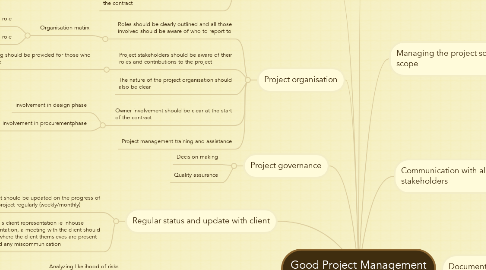Good Project Management Practices
by Ibtisam Ali


1. Create contingency and risk management plans
1.1. Analyzing likelihood of risks
1.2. Mitigating risks
1.3. Accepting of risks and contingency plans that follow
2. Ensure a proper introduction and closing to your project and project team
2.1. The beginning of a project should be formally attended by the project manager, the project team, and preferbly the client.
3. Budget management
3.1. A clear budget should be agreed on and set before the beginning of any works
3.2. All budget details should be clearly outlined in the contract
4. Regular status and update with client
4.1. Client should be updated on the progress of the project regularly (weekly/monthly)
4.2. If there is client representation ie inhouse representation, a meeting with the client should be set where the client themsleves are present to avoid any miscommunication
5. Project governance
5.1. Decision making
5.2. Quality assurance
6. Project organisation
6.1. Roles should be clearly outlined and all those involved should be aware of who to report to
6.1.1. Organisation matirx
6.1.1.1. Define project managers role
6.1.1.2. Define clients role
6.2. Project stakeholders should be aware of their roles and contributions to the project
6.2.1. Training should be provided for those who require
6.3. The nature of the project organisation should also be clear
6.4. Owner involvement should be clear at the start of the contract
6.4.1. involvement in design phase
6.4.2. involvement in procurementphase
6.5. Project management training and assistance
7. Communication with all project stakeholders
7.1. The project manager should be in communication to all project stakeholders and must be aware of the progression of the projects at all points
7.2. If a project involves more than two parties working together, there should be clear communication between parties, with scheduled meetings to discuss problem matters in person
8. Documentation of everything throughout the project
8.1. Documentation method
8.1.1. Emails
8.1.2. Formal database of information
8.2. Documentation should be available to those necessary (client, project sponsor and project manager)
8.3. Documentation should be dealt with security
8.3.1. Information access
8.4. Information control and reporting
8.4.1. Any documented information should be
9. Ask for an implement feedback
9.1. Project feedback from client and others involved with the project is important in order to impliment lessons learned
9.2. Assessment of the project successes and failures should also be assessed and analysed
10. Managing the project schedule and scope
10.1. The scope of the project should be clear to all parties involves in the project. This includes, the project manager, the client, any representative of the client, and any other personnel that is directly involved in the project
10.2. The project scope should initially be clear from the client. Clarification of the project scope should be clear and in the contact before the beginning of any works
10.2.1. Contract and working contracts should be included. This will outline the input and contribution the client has throughout the duration of the project
